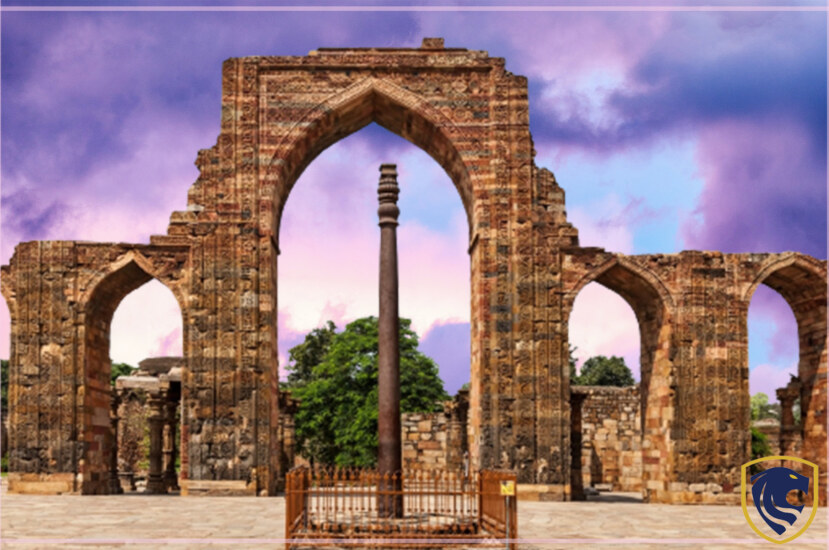The Iron Pillar at Delhi’s Qutub complex is a large, thin, and almost cylindrical pillar of red sandstone. It dates back to the 2nd century BC. Though construction began during the reign of Chandragupta II Vikramaditya (375-414 AD) it is believed that it was completed by his successor Kumaragupta I Vikramaditya (450-475 AD). It is also said that Vikramaditya was unhappy with its sturdiness and ordered another pillar be made from steel.
In 1970, a massive earthquake struck Delhi, and this Pillar suffered severe damage while being engulfed in the rubble of collapsed buildings. Nonetheless, it still stood straight and true. In order to restore it, a replica was forged from the original’s remains and affixed on top of the Pillar, effectively restoring its original height.
The Pillar’s height was 19 ft, 3/16 inches, or 5.85 meters when it was first erected. Presently, however, it stands at approximately 13 ft, 2/9 inches, or 4.1 meters due to centuries of wear & tear and the addition of the replica at its top.
What is it made of?
The Pillar is made up of 98% pure iron and is believed to be an isolated example in ancient metallurgy since no trace of rust has been found on it despite being exposed to wind & rain for over 1600 years. This Pillar has become a popular tourist destination in Delhi.
There are two legends associated with this Pillar. One is that the Pillar was erected to mark the high point of a bridge across the Yamuna River. The other is that it was constructed as an offering to either Vishnu or Shiva. And remained where it was left after completion. The story of the former is substantiated by archaeological evidence found at the very spot where the pillars stand, a semi-circular mound of earth that sits at the end of an ancient thoroughfare known as Chandrabhaga. In this mound, several coins and stone tools were found. These were dated back to the 3rd century BC.
Who constructed it?
However, there is no archeological evidence in support of the Pillar being a resting place for an idol or altar. Thus it has been proposed that the Pillar was commissioned by Chandragupta II Vikramaditya (375-414 AD) to commemorate his conquest of Saurashtra in Gujarat.
The Pillar is fashioned as a single, unbroken piece of iron. That is about 20 cm in diameter at the base and tapering to a thickness of about 3 cm at the top. The roundness of this Pillar differs from other archaeological artifacts from the first millennium BC. Such as cylinders, pillars, rings, and stone axes. This can be due to the use of an iron alloy (or “bund”) that was easily worked into shape. Like all iron artifacts during this period, its physical attributes suggest it was not hammered out. But rather forged with a “forge-welding” process. Its solidity and strength are further emphasized by the remnant of its centripetal welded seam, a feature that is typical of iron objects forged with this technique.
It is believed that the Pillar was originally placed in the middle of a road to commemorate an important battle victory. Many prominent monuments were erected or consecrated at important sites such as royal capitals, religious pylons, and battlefields for their aesthetic beauty and propaganda purposes. Because of this, it has been proposed that this Pillar was indeed erected in order to provide a visual landmark for travelers. This may also explain why the Pillar’s position was not changed even after it had sustained severe damage due to Delhi’s earthquake.

The pillar that stands 1600 years without rust; the Iron pillar of Delhi
What is the mystery behind Iron Pillar?
The Pillar is made of high-quality wrought iron and weighs 6 tons. The iron used to create this Pillar is 98% pure iron, of unparalleled quality. It is so pure that scientists have even been unable to reproduce it today!
The Iron Pillar of Delhi is the first and only known instance of a piece of metalwork from ancient India. That has withstood the ravages of time and the elements to leave us such detailed documentation of its making and erection.
The Iron Pillar of Delhi is a single metal shaft that stands in the Qutub Complex at Mehrauli in Delhi. The Pillar stands 5.3 m (17 ft) tall, with a diameter of 50 cm (20 in), and weighs over six tons. It is made entirely out of cast iron and has stood outdoors without rusting for 1600 years! Archaeologists are still unsure why it resisted corrosion for so long or how it was cast.
The Pillar bears inscriptions on its three sides, which detail its erection by one Ashoka the Great and subsequent repairs to it by Queen Samudra Devi and her son Anangpal. It also has two Sanskrit verses inscribed on it. The base of the Pillar has carvings of Brahma, Indra, and Vishnu.
The history of this magnificent iron pillar is hard to trace, and there are no records to mention how the Pillar came into being. Many believe that it was erected during Ashoka’s time (304-232 BC). This is, however, not known for sure; historians have come up with varied versions of its origin.
Why does the iron pillar of Delhi not rusted?
The Iron Pillar of Delhi is a marvel of ancient Indian metallurgy and cultural engineering. The Pillar is made from 98% wrought iron without a trace of rust or decay. While scholars have been debating the origin and construction methods for centuries, it finally seems to have been solved.
One theory goes that the Pillar was produced using an ancient blacksmithing technique called wootz steel, also known as “oriental steel,” which was somehow lost to history with no clear demonstration for modern metalworkers. Wootz steel is composed of an alloy of 78% carbon, 12% manganese, 2% sulfur, and 2% phosphorus. The alloy is thermally stable up to 1200 degrees Celsius. Today’s Damascus steel, which requires temperatures up to 1500°C, was produced by the same method.
The Pillar also contains a mixture of six metals never before found in a single ingot or block. Such as copper and gold mixed with tin, lead, and mercury alloyed into an extremely tough composite substance. The Pillar is the only example of its kind in the world and remains free of rust or decay. It is also one of the largest iron artifacts in the world.
What do we know about the Iron Pillar of Delhi?
No records in ancient texts tell us about the story behind this stunning piece of ironwork. However, some facts can be gleaned from studying literary evidence and conducting scientific studies on it.
According to historians, the Pillar has existed for more than 1600 years. It is believed to have been constructed during the 3rd century BC by Chandragupta II Vikramaditya. It was subsequently repaired in the 8th century AD by command of King Vikramaditya Varman and his queen, Lalithambika.

The pillar that stands 1600 years without rust; the Iron pillar of Delhi
The base of the Pillar is embellished with three inscriptions made during different phases of its existence. The first inscription dates back to 643 AD and mentions that it was erected by one Rastrapala, who served as a Governor under sixth-century ruler Harsha Vardhana. The inscription appears to have been made during the re-installation of the Pillar.
The second inscription
The second inscription, which is located on the eastern side of the Pillar, was made by Birbhadra. Birbhadra is a poet in the court of Harsha Vardhana. It talks about an event that occurred in 654 AD when a large banyan tree fell on this Pillar and damaged it. The poet claims that he was responsible for fixing this damage. The inscription also mentions that Samudradevi and Anangapala gave him ‘supari’ (betel leaves) for his work!
The third and final inscription is located at the bottom of the Pillar. It was created in the 11th century AD, during the reign of Rajendra Chola I. This inscription was made by a local official named Vallalasena. It mentions a certain ‘Anantejjyasa,’ who had settled in Delhi after his return from ‘Mahapura’ (now known as Sri Lanka). He gave this Pillar to the king and queen of the time, Samudradevi and Anangapala, as a thank you for their care and attention. He also mentions that this Pillar is made of metal (Jala) and will not be affected by rust. The inscriptions suggest that the Pillar was repaired and maintained over generations.




